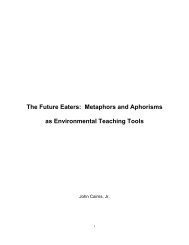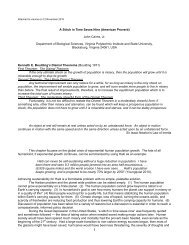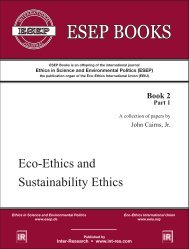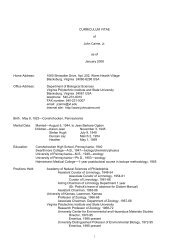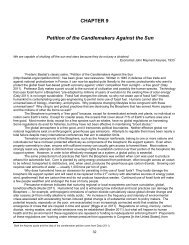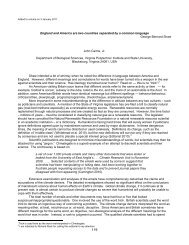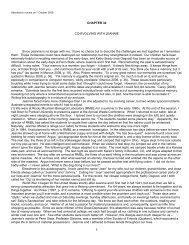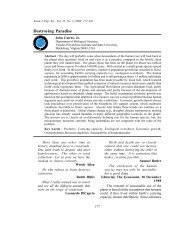View - ResearchGate
View - ResearchGate
View - ResearchGate
You also want an ePaper? Increase the reach of your titles
YUMPU automatically turns print PDFs into web optimized ePapers that Google loves.
Article 24207ability issues, I began writing a series of commentaries on the subject in its local newsletter (e.g.,Cairns, 1997c,d). Although some months have passed since the first commentary, I have receivedno comment, pro or con, on any of them.A newly forming, local group that is purportedly interested in bioregional planning has failed to seethe connection between bioregional planning and land trusts designed to preserve the ecologicalattributes of a particular piece or property in perpetuity. This lack of understanding is not an encouragingsign because it does not appear that major changes in societal behavior will occur on thebasis of information alone. Still, the attempt must be made since the biophysical laws of nature willprovide consequences if nothing is done beforehand. At the very least, discussions will likely leavesociety better prepared when the consequences do occur. A reasonable first step is speculationabout possible scenarios.(1) Significant action is taken towards sustainable use of the planet based on information alone,despite uncertainty about the precise outcome.This scenario is, in a very real sense, a race between consilience and consequences. If severe environmentalproblems develop before any significant sustainability initiatives are undertaken, no onewill ever know whether human society was capable of acting on the basis of information alone.Wilson’s (1998a,b) consilience hypothesis indicates that a major dynamic leap forward might welloccur, rather than painfully slow incremental advances. Whether the sort of synthesis of knowledgenecessary to implement successful sustainability will occur is definitely uncertain, although the consiliencehypothesis makes this seem more probable than it once did. Certainly, this outcome is themost desirable and is one advocated by a number of leaders in the field (Abernethy, 1997; Myers,1997; Tullberg and Tullberg, 1997). Even though these authors might not be optimistic about the outcome,the time they have invested in defining the problem indicates they believe that a reasonableprobability of successful implementation of sustainability is a hope. Such meetings as IndustrialEcology III of the Future 500 on April 24–26, 1998 in the Marin Headlands of Northern Californiaindicate that scenario (1) is still possible.(2) Human society is intellectually persuaded that sustainability is good, but it is emotionally incapableof making the necessary behavioral changes until a particular incident persuades it that postponementof change is no longer possible.The spectrum of events to illustrate this situation is so broad that even a list would be extensive.One such happening would be the final loss of the Ogalala aquifer, extending from Texas to Canada,in which water is being pumped out at a rate greater than recharge. This loss would cause a majoralteration of agricultural productivity in the United States. Another major alteration would be themelting of the polar ice caps, which would affect some of the low-lying islands, such as the MaldiveIslands in the Indian Ocean, or sections of the United States such as Florida. This scenario is thesecond best option for reaching sustainable use of the planet because human society may suffer butmay still have the resources to make effective changes toward sustainability in time.(3) Multiple, severe consequences occur but human society is in a state of denial (e.g., Orr andEhrenfeld, 1995) about the primary causes.Clearly, doing nothing while waiting for better evidence of danger is not risk free.(4) Technological solutions are attempted or explored instead of changing societal behavior.



